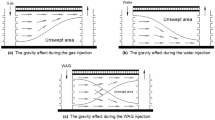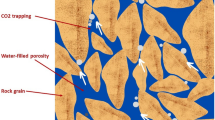Abstract
Underground storage in geological aquifers is one of the most important options for large-scale mitigation of CO2. During the supercritical CO2 (scCO2) injection process, water dissolved in scCO2 may have significant impact on the displacement process. In this study, a series of wet scCO2 (WscCO2, 100% water saturation) and dry scCO2 (DscCO2, 0% water saturation) displacement experiments were conducted in micromodels for a large range of flow rates. The displacement was visualized using fluorescence microscopy. Results showed that DscCO2 saturations were up to 3.3 times larger than WscCO2 saturations when the capillary fingering dominated the displacement. The specific interfacial areas and mobile fractions for the DscCO2 displacements were also much larger than those for WscCO2. The capillary forces combined with drying effects are identified as the leading causes for the considerably higher DscCO2 sweep efficiency. Results from this study showed the important impact of mutual solubility of scCO2 and water on the displacement process and saturation of scCO2 (SscCO2), suggesting that the conventional model describing the relationship between capillary pressure and SscCO2 needs to be modified for the effect of the mutual dissolution of multiple phases to more adequately describe the scCO2 displacement process in saline aquifer formation.




Similar content being viewed by others
References
Bachu S, Brant B (2008) Effects of in-situ conditions on relative permeability characteristics of CO2 -brine systems. Environ Geol 54:1707–1722. https://doi.org/10.1007/s00254-007-0946-9
Bachu S, Brant Bennion D (2009) Dependence of CO2 -brine interfacial tension on aquifer pressure, temperature and water salinity. Energy Procedia 1:3157–3164
Bennion B, Bachu S (2005) Relative permeability characteristics for supercritical CO2 Displacing water in a variety of potential sequestration zones in the Western Canada Sedimentary Basin. SPE 95547:1–15. https://doi.org/10.2118/95547-MS
Bennion B, Bachu S (2006a) The impact of interfacial tension and pore-size distribution/capillary pressure character on CO2 relative permeability at reservoir conditions in CO2 -brine systems. SPE/DOE symp improv oil recover Tula, Oklahoma, USA, April 22–26. https://doi.org/10.2118/99325-MS
Bennion D, Bachu S (2006b) Dependence on temperature, pressure, and salinity of the IFT and relative permeability displacement characteristics of CO2 Injected in deep saline aquifers. SPE Annu Tech Conf. https://doi.org/10.2118/102138-MS
Bennion DB, Bachu S (2006c) Supercritical CO2 and H2S brine drainage and imbibition relative permeability relationships for intergranular sandstone and carbonate formations. SPE Eur Annu Conf Exhib Vienna, Austria, 12–15 June 12–15. https://doi.org/10.2523/99326-MS
Bennion B, Bachu S (2007a) Permeability and relative permeability measurements at reservoir conditions for CO2–water systems in ultra low permeability confining caprocks. Proc Eur Conf Exhib 1–9. https://doi.org/10.2118/106995-MS
Bennion DB, Bachu S (2007b) SPE 106995 permeability and relative permeability measurements at reservoir conditions for CO2 –water systems in ultralow-permeability confining Caprocks. SPE
Bennion B, Bachu S (2008) Drainage and imbibition relative permeability relationships for supercritical CO2/Brine and H2S/Brine systems in intergranular Sandstone, Carbonate, Shale, and anhydrite rocks. SPE Reserv Eval Eng 11:487–496. https://doi.org/10.2118/99326-PA
Choi YH, Kim J, Noh MJ et al (1998) Effect of functional groups on the solubilities of coumarin derivatives in supercritical carbon dioxide. Chromatographia 47:93–97. https://doi.org/10.1007/BF02466793
Chomsurin C (2003) Analysis of pore-scale nonaqueous phase liquid dissolution in etched silicon pore networks. Water Resour Res 39(9):1265–1275. https://doi.org/10.1029/2002WR001643
Cottin C, Bodiguel H, Colin A (2010) Drainage in two-dimensional porous media: from capillary fingering to viscous flow. Phys Rev E Stat Nonlinear Soft Matter Phys. https://doi.org/10.1103/PhysRevE.82.046315
DeHoff KJ, Oostrom M, Zhang C, Grate JW (2012) Evaluation of two-phase relative permeability and capillary pressure relations for unstable displacements in a pore network. Vadose Zo J. https://doi.org/10.2136/vzj2012.0024
Ferer M, Ji C, Bromhal GS et al (2004) Crossover from capillary fingering to viscous fingering for immiscible unstable flow: Experiment and modeling. Phys Rev E Stat Nonlinear Soft Matter Phys. https://doi.org/10.1103/PhysRevE.70.016303
Hatiboglu CU, Babadagli T (2010) Experimental and visual analysis of co- and counter-current spontaneous imbibition for different viscosity ratios, interfacial tensions, and wettabilities. J Pet Sci Eng 70:214–228. https://doi.org/10.1016/j.petrol.2009.11.013
Kazemifar F, Blois G, Kyritsis CD, Christensen TK (2016) Quantifying the flow dynamics of supercritical CO2–water displacement in a 2D porous micromodel using fluorescent microscopy and microscopic PIV. Adv Water Resour 95:352–368
Lengler U, De Lucia M, Kühn M (2010) The impact of heterogeneity on the distribution of CO2: numerical simulation of CO2 storage at Ketzin. Int J Greenh Gas Control 4:1016–1025. https://doi.org/10.1016/j.ijggc.2010.07.004
Lenormand R, Touboul E, Zarcone C (1988) Numerical models and experiments on immiscible displacements in porous media. J Fluid Mech 189:165. https://doi.org/10.1017/S0022112088000953
Lopez O, Idowu N, Mock A et al (2011) Pore-scale modelling of CO2-brine flow properties at In Salah, Algeria. Energy Procedia 4:3762–3769. https://doi.org/10.1016/j.egypro.2011.02.310
Loring JS, Wang Z, Thompson CJ et al (2010) Carbonation of forsterite exposed to water-saturated supercritical carbon dioxide. Geochim Cosmochim Acta 74:A631–A631
Loring JS, Thompson CJ, Wang Z et al (2011) In situ infrared spectroscopic study of forsterite carbonation in wet supercritical CO2. Environ Sci Technol 45:6204–6210. https://doi.org/10.1021/es201284e
Loring JS, Thompson CJ, Zhang C et al (2012) In situ infrared spectroscopic study of brucite carbonation in dry to water-saturated supercritical carbon dioxide. J Phys Chem A 116:4768–4777. https://doi.org/10.1021/jp210020t
Lu C, Han WS, Lee SY et al (2009) Effects of density and mutual solubility of a CO2-brine system on CO2 storage in geological formations: “Warm” vs. “cold” formations. Adv Water Resour 32:1685–1702. https://doi.org/10.1016/j.advwatres.2009.07.008
Mahadevan J, Sharma MM, Yortsos YC (2007) Water removal from porous media by gas injection: experiments and simulation. Transp Porous Media 66:287–309. https://doi.org/10.1007/s11242-006-0030-z
McCaughan J, Iglauer S, Bresme F (2013) Molecular dynamics simulation of water/CO2-quartz interfacial properties: Application to subsurface gas injection. Energy Procedia 37:5387–5402. https://doi.org/10.1016/j.egypro.2013.06.457
Metz B, Davidson O, de Coninck H et al (2005) IPCC Special Report on Carbon Dioxide Capture and Storage
Mohammadi S, Hossein Ghazanfari M, Masihi M (2013) A pore-level screening study on miscible/immiscible displacements in heterogeneous models. J Pet Sci Eng 110:40–54. https://doi.org/10.1016/j.petrol.2013.08.043
Nordbotten JM, Celia MA, Bachu S (2005) Injection and storage of CO2 in deep saline aquifers: analytical solution for CO2 plume evolution during injection. Transp Porous Media 58:339–360. https://doi.org/10.1007/s11242-004-0670-9
Pruess K (2009) Formation dry-out from CO2 injection into saline aquifers: 2. analytical model for salt precipitation. Water Resour Res. https://doi.org/10.1029/2008WR007102
Pruess K, Müller N (2009) Formation dry-out from CO2 injection into saline aquifers: 1. effects of solids precipitation and their mitigation. Water Resour Res. https://doi.org/10.1029/2008WR007101
Roman S, Soulaine C, AlSaud MA et al (2016) Paricle velocimetry analysis of immiscible two-phase flow in micromodels. Adv Water Resour 95:199–211
Sohrabi M, Kechut NI, Riazi M et al (2011) Safe storage of CO2 together with improved oil recovery by CO2-enriched water injection. Chem Eng Res Des 89:1865–1872. https://doi.org/10.1016/j.cherd.2011.01.027
Spycher N, Pruess K, Ennis-King J (2003) CO2-H2O mixtures in the geological sequestration of CO2. I. Assessment and calculation of mutual solubilities from 12 to 100 °C and up to 600 bar. Geochim Cosmochim Acta 67:3015–3031. https://doi.org/10.1016/S0016-7037(03)00273-4
Takeshi T, Fei J, Kenneth TC (2016) Characterization of immiscible fluid displacement processes with various capillary numbers and viscosity ratios in 3D natural sandstone. Adv Water Resour 95:3–15
Wang Y, Zhang C, Wei N et al (2013a) Experimental study of crossover from capillary to viscous fingering for supercritical CO2–water displacement in a homogeneous pore network. Environ Sci Technol 47:212–218. https://doi.org/10.1021/es3014503
Wang Z, Felmy AR, Thompson CJ et al (2013b) Near-infrared spectroscopic investigation of water in supercritical CO2 and the effect of CaCl2. Fluid Phase Equilib 338:155–163. https://doi.org/10.1016/j.fluid.2012.11.012
Willingham TW, Werth CJ, Valocchi AJ (2008) Evaluation of the effects of porous media structure on mixing-controlled reactions using pore-scale modeling and micromodel experiments. Environ Sci Technol 42:3185–3193. https://doi.org/10.1021/es7022835
Xu T, Apps JA, Pruess K (2005) Mineral sequestration of carbon dioxide in a sandstone-shale system. Chem Geol 217:295–318
Zhang C, Oostrom M, Grate JW et al (2011a) Liquid CO2 displacement of water in a dual-permeability pore network micromodel. Environ Sci Technol 45:7581–7588. https://doi.org/10.1021/es201858r
Zhang C, Oostrom M, Wietsma TW et al (2011b) Influence of viscous and capillary forces on immiscible fluid displacement: Pore-scale experimental study in a water-wet micromodel demonstrating viscous and capillary fingering. Energy Fuels 25:3493–3505. https://doi.org/10.1021/ef101732k
Zhao Y, Song Y, Liu Y et al (2011) Visualization of CO2 and oil immiscible and miscible flow processes in porous media using NMR micro-imaging. Pet Sci 8:183–193. https://doi.org/10.1007/s12182-011-0133-1
Zhou Q, Birkholzer JT, Mehnert E et al (2010) Modeling basin- and plume-scale processes of CO2 storage for full-scale deployment. Ground Water 48:494–514. https://doi.org/10.1111/j.1745-6584.2009.00657.x
Zuo L, Zhang C, Falta RW, Benson SM (2013) Micromodel investigations of CO2 exsolution from carbonated water in sedimentary rocks. Adv Water Resour 53:188–197. https://doi.org/10.1016/j.advwatres.2012.11.004
Acknowledgements
All experiments in this research were performed at the William R. Wiley Environmental Molecular Science Laboratory (EMSL), a national scientific user facility sponsored by the US Department of Energy’s Office of Biological and Environmental Research and located at the Pacific Northwest National Laboratory, operated for the Department of Energy by Battelle.
Funding
This work was supported by the 973 Program of China [Grant number 2014CB239205]; National Natural Science Foundation of China [Grant numbers 41304081]; and Open fund of State Key Laboratory of Oil and Gas Reservoir Geology and Exploitation (Southwest Petroleum University) [Grant numbers PLN201601].
Author information
Authors and Affiliations
Corresponding authors
Additional information
Publisher’s Note
Springer Nature remains neutral with regard to jurisdictional claims in published maps and institutional affiliations.
Electronic supplementary material
Below is the link to the electronic supplementary material.
Rights and permissions
About this article
Cite this article
Wang, Y., Wei, N., Zhang, C. et al. Experimental study of drying effects during supercritical CO2 displacement in a pore network. Microfluid Nanofluid 22, 101 (2018). https://doi.org/10.1007/s10404-018-2122-9
Received:
Accepted:
Published:
DOI: https://doi.org/10.1007/s10404-018-2122-9




